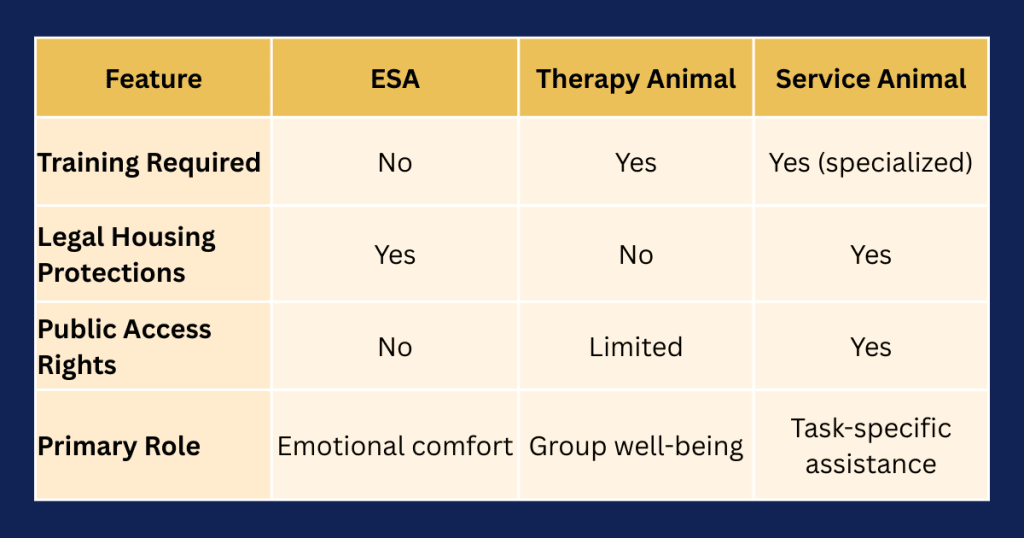PTSD, anxiety, and bipolar disorder aren’t just labels on a chart—they’re lived experiences that can shape every moment of a person’s day. These conditions ripple into relationships, work, and even the quiet moments alone at home. While medical care is essential, many people seek something more tangible, something warm and alive, to help them navigate their mental health journey.
That’s where Emotional Support Animals (ESAs) come in. Emotional Support Animals (ESAs) help individuals with PTSD, anxiety, and bipolar disorder by providing comfort, emotional grounding, and reducing symptoms through companionship and non-judgmental presence.
Key Takeaways
- ESAs provide emotional stability by offering consistent comfort that helps manage PTSD, anxiety, and bipolar disorder symptoms.
- Animal companionship promotes physiological calm through lowered stress hormones and regulated heart rate.
- Daily care routines from ESAs create structure and encourage healthy, purposeful habits.
- ESAs complement professional treatment as a supportive tool alongside therapy and medication.
- Legal protections under the Fair Housing Act allow individuals with valid ESA documentation to live with their animals despite pet restrictions.
Mechanisms Through Which ESAs Improve Mental Health
Biological & Physiological Benefits
The body responds in remarkable ways to time spent with an ESA, from increased oxytocin that fosters trust to lowered cortisol that eases tension. Blood pressure and heart rate often settle into calmer rhythms, reflecting the quiet stability these animals bring. These are not fleeting sensations but tangible shifts in the body’s stress systems that help offset mental health turbulence.
Emotional & Psychological Effects
Unconditional acceptance from an ESA offers grounding when emotions spiral and mood shifts feel overwhelming. They break isolation by providing purpose and connection, encouraging a gentle re-engagement with life. Over time, this companionship can reshape resilience and influence how one relates to both self and others.
Behavioral & Social Dynamics
Daily care tasks like feeding, walks, and grooming add healthy structure to days that might otherwise feel unmoored. These routines often spark organic social interactions and provide reasons to step outside. An ESA’s presence can also make therapy sessions and exposure work feel safer and more approachable.
ESA Benefits for Specific Conditions

PTSD
PTSD can make the world feel like a minefield of triggers. The hyperarousal, flashbacks, and intrusive thoughts can leave someone constantly on guard. An ESA provides a counterpoint to that vigilance, offering a safe presence that can interrupt spirals and draw focus back to the present. In moments of panic or emotional flooding, simply stroking an animal’s fur can become a grounding exercise.
Anxiety & Panic Disorders
Anxiety thrives on uncertainty, and panic attacks can make everyday life feel unpredictable. ESAs act like emotional stabilizers, offering a calming presence that can help regulate breathing, heart rate, and thoughts during anxious episodes. Over time, this consistency can build confidence, making it easier to face situations that once felt overwhelming.
Bipolar Disorder
Mood swings in bipolar disorder can be intense—soaring highs and crushing lows that affect not only the person experiencing them but also their loved ones. ESAs can help soften those extremes. During manic phases, they provide a steadying influence, reminding their person to pause, rest, and maintain routines. In depressive phases, they offer comfort, warmth, and a reason to get out of bed.
Broader Psychiatric Conditions
While much of the conversation focuses on PTSD, anxiety, and bipolar disorder, ESAs have also been helpful for individuals with depression, schizophrenia, and other psychiatric conditions. In these cases, they serve as complementary support, not as a replacement for therapy or medication, but as an added layer of emotional reinforcement.
Complementary Uses: Therapy & Service Animals vs ESAs
Therapy Animals
Therapy animals work in structured environments like schools, hospitals, or rehabilitation centers. They’re trained to interact with many people, offering general comfort and improving well-being in group or institutional settings. Unlike ESAs, they aren’t assigned to one person and don’t live with them full-time.
Service Animals (Psychiatric Service Dogs)
Service animals, particularly psychiatric service dogs, undergo specialized training to perform tasks directly related to their handler’s disability. This might include interrupting flashbacks, applying deep-pressure therapy during anxiety episodes, or reminding their person to take medication.
Clear Comparison Table

Scientific & Clinical Evidence Supporting ESAs
Research on Emotional Support Animals (ESAs) is still developing, but current findings are promising. Studies have demonstrated that interactions with animals can lower cortisol levels, reduce anxiety, and enhance mood regulation. For individuals with PTSD, animal companionship has been shown to decrease the frequency and intensity of symptoms. While ESAs are not a cure, they can serve as a valuable component of a comprehensive treatment plan.
Real-world stories highlight these benefits vividly—for example, a veteran finding it easier to sleep through the night with a dog by their side, or someone with panic disorder rediscovering the freedom to leave their home without fear.
Legal, Ethical & Practical Considerations

Governance & Documentation
In the United States, ESAs are protected under laws like the Fair Housing Act and Section 504 of the Rehabilitation Act. These laws ensure that individuals with valid ESA documentation from a licensed mental health professional can live with their animal even in housing with pet restrictions. However, airline policies have changed in recent years, limiting ESA travel privileges.
Ethical Considerations
As awareness of ESAs grows, so does the potential for misuse. Fraudulent letters and untrained animals can undermine the credibility of legitimate ESAs, leading to public backlash and tighter regulations. Responsible ownership and proper documentation are essential.
Practical Concerns
Owning an ESA isn’t without challenges. There are costs for food, veterinary care, and training. Landlord resistance can still occur, and travel may require extra planning. For clinicians, issuing an ESA letter carries a responsibility to ensure that the recommendation is appropriate and well-documented.
How Emotional Support Animals Improve PTSD, Anxiety & Bipolar Disorder
At Emma & Buddy, we know Emotional Support Animals offer more than companionship—they create a bridge between medical treatment and the everyday realities of living with PTSD, anxiety, and bipolar disorder. They bring structure, comfort, and a non-judgmental presence that can transform days from simply surviving to genuinely thriving.
We believe in the beauty of this bond because we’ve seen it firsthand through the stories and experiences shared within our community. The right animal, matched with the right person, can form a partnership that nurtures healing on both ends of the leash. In a world that often moves too fast, ESAs remind us to slow down, breathe, and embrace the simple, transformative power of connection.













